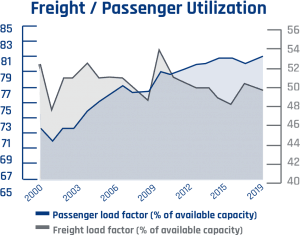A key to efficiency and profitability in commerce is the ability to match supply with demand at its optimal, market-based price, and make that pricing available to customers – all in real time.
Likewise, opacity creates inefficiency: it either lets capacity go to waste or leaves money on the table by underselling a valuable commodity.
Market-optimized pricing and capacity will finally become the standard in air cargo – if the industry is able to follow the lead of other industries, including passenger air travel, that have leveraged digitization to reach this goal.
Other industries have leveraged this digital shift
The digital era has introduced multiple technological solutions that make latent capacity visible and accessible to the market – Amazon does this for shelf space, Airbnb for hotel rooms, and Uber for transportation. In every case these have not only optimized an existing market but expanded the market.
But the shift these companies made was first and foremost one of culture and business model. It began with the commitment to do what is necessary to identify and then utilize all available space. That vision could then be implemented by developing the necessary technological capabilities to get there.
Passenger air travel is another good example.
The industry took its first digital steps to make capacity visible and accessible when American Airlines hired IBM to develop its SABRE computer reservations system already way back in the early 1960s. This development continued on a steady forward march resulting in customers being able to book their own flights online by 1996.
All these steps resulted not only in lower costs for the airlines and more convenience for consumers, but also in the airlines’ better use of capacity and improved profitability: this digital revolution allowed passenger load factors to steadily improve from about 65% in the mid-90s to better than 80% in recent years. There has been growth in revenue of airlines, a reduction in price to consumer, and an increase in utilization. Improved utilization also means an improved carbon footprint per passenger.

Air cargo is a different story
For an industry whose core added value is speed, air carriers are way slower and less efficient in delivering supply to below-deck consumers than the passenger airlines are at booking seats on the upper deck.
The majority of cargo bookings are still done by phone and email, with recent research showing that shippers often wait 2-3 days just to receive a quote. Making a booking can also take several hours, can only be done during airlines’ business hours, and rarely includes guaranteed space on a specific flight. And while paper passenger tickets are long gone, half of airway bills are still paper.
These manual processes that start with the air carriers trickle down to the GSAs (air cargo sales agents) and freight forwarders and multiply the inefficiency and lag. For example, information for a typical booking is re-typed 97 times (IATA data) throughout the booking process multiplying the chances for errors and delays.
All these factors combine to hit the air carrier’s bottom line: air cargo load factor has hovered around 50% for decades even while the upper decks filled up.

But change is already possible
Digital Air Cargo (DAC) is the concept around which air cargo can be transformed both culturally and technologically. DAC maps out the entire ecosystem that can align carriers, forwarders/GSAs and shippers to enable a real-time matching of capacity with demand at optimized prices. The end result would be cargo that takes 2-3 days from inquiry to delivery, with reduced costs, improved load factors and revenue, and delighted customers. Having better service at lower prices with less overhead will expand the market for everyone.
This cultural shift – the decision to take whatever steps are necessary to optimize operations – would entail the following key changes to the traditional air cargo business model:
- Unified pricing worldwide instead of different prices offered to different countries or different channels.
- Dynamic pricing replacing seasonal prices and ad hoc negotiations – enabled, for example, by index-linked rates that can adjust and react to market realities.
- Standard BSAs (Bilateral Security Agreements) instead of informal agreements and bookings.
The technological solutions needed to implement this vision are already available and include:
- Capacity management, digitized and updated in real-time.
- Revenue management through real-time dynamic pricing which respond to capacity and market conditions at least daily.
- Ebooking APIs to allow customers 24-hour automated access to carrier capacity.
- Rapid response rate – all this must be able to take place nearly instantly, to give customers the type of online service they expect across industries.
DAC is already taking hold among industry leaders, and WebCargo by Freightos is proud to be part of this transformation: the WebCargo and Freightos suite of solutions helps create the ecosystem that connects carriers with freight forwarders and shippers.
Though the changes needed to get there are not easy, Digital Air Cargo represents the bold opportunity for airlines to make air cargo less costly, faster, and more reliable.
To learn more, download the Digital Air Cargo vision paper here.




